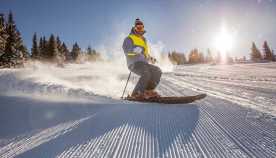AARP Eye Center
- right_container
- Health
- Money
- Work & Jobs
- Advocacy
- Social Security
- Medicare
- Caregiving
- Games
- Travel
- More...
- Entertainment & Style
- Family & Relationships
- Personal Tech
- Home & Living
- Auto
- Staying Sharp
- Podcasts
- Videos
The Howard B. Owens Science Center Planetarium
Our Mission
The Howard B. Owens Science Center, (HBOSC), a 27,500 square foot facility owned and operated by the Prince George's County Public Schools, has as its mission to provide excellence in science, technology, engineering, and mathematics (STEM) education through student centered programs and services. The Center seeks to provide students in grades Pre-K through 12, with opportunities to participate in unique activity-based instruction. Our staff of teachers practices their craft from teacher developed curriculum materials that approach STEM literacy from the perspective of developmental, exploratory learning. Hands-on, data intensive activities provide students with experiences in physics, chemistry, physiology, biology, space science education, paleontology, meteorology, optics, nutrition, computer science, and astronomy. Teachers on site continuously develop new programs and update current offerings. HBOSC serves as an extension of the classroom, designing, supporting and augmenting classroom activities as they relate to science instruction.
It is becoming increasingly important that we develop a citizenry adept at accessing and utilizing the results of technology for professional, community and personal use. Knowing where to find information and how to use the technology that provides access to it will are important skills as we move to a more global society. The development of informed decision makers is critical to individual and national success.
History:
Howard Beauchamp (pronounced Beech-um) Owens was born November 17, 1909 in Betterton, Maryland, the son of Howard Franklyn Owens and Anna Knotts Beauchamp Owens. His father had a degree from Washington College in Chestertown, Md., and was a prominent businessman in Kent County. His mother had a mathematics degree from Washington College, which was unusual for a woman in those days. She managed the Royal Swan Hotel, a business that attracted tourists and prominent hunters to the area to hunt on the nearby Great Susquehanna Flats. Betterton is a small town on the Chesapeake Bay’s Eastern Shore that had popular bathing beaches and was a hub for recreational activities. Large pleasure boats brought tourists there from Baltimore and Philadelphia until some time in the 1960’s.
At the age of two, he contracted polio, an acute viral disease of the nervous system that can cause partial paralysis, muscular atrophy, and permanent deformities. He wore braces on his legs until he was nine, and a doctor told his parents not only that he would probably not live past the age of 20, but also that they should place him in a home for crippled children because he would be too much trouble for them. Having none of this, his mother and father massaged his legs daily, and encouraged and taught him in every way possible. Optimistic and persevering by nature, “Beach,” as his family called him, always pushed himself to do what everyone else could do. He thrived, and proved the doctor wrong.
Like other children of his day, Beach walked to school, and these twice-daily walks along quiet roads and trails instilled a life-long love of nature. When he was a little older, he would often go duck hunting early in the morning, or check his trap lines before hurrying to get to school on time. He was an excellent student, and showed great interest in learning. He always loved books, and was a voracious reader. The keen curiosity he had, particularly about nature and exploration, followed him throughout his life.
AARP Events for Waymart
-
Featured Event
Moving With Milly for Improved Mobility
Monday, Apr 14, 2025 at 11:00 a.m. ET
Online Event
-
Featured Event
Spring Walking at Saucon Rail Trail
Tuesday, Apr 15, 2025 at 10:00 a.m. ET
Saucon Rail Trail - Upper Saucon Township Park
Center Valley, PA
-
Featured Event
Yoga & Mindfulness Series: Gentle Movement
Thursday, Apr 17, 2025 at 1:00 p.m. ET
Zoom
Online Event

New Pricing Coming in 2025.
This is AARP's first rate increase in 15 years.
Don't miss out, join today and save!
















)


















.jpg?crop=true&anchor=13,195&q=80&color=ffffffff&u=lywnjt&w=2008&h=1154)




























